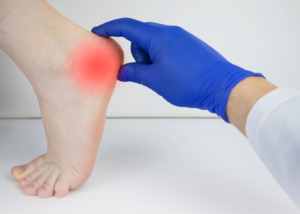If you’ve been told that you have poor circulation, it means that you have less blood reaching certain areas of the body than what is ‘normal’ – and what is needed for optimal tissue health. Poor circulation can affect the function of every cell – and your body’s ability to maintain healthy function. Today, the Sole Motion Podiatry team are sharing what circulation problems may mean for you and your foot health.
Circulation: The Basics
Your heart is responsible for pumping oxygen-rich blood and nutrients around your body via your arteries. Once the oxygen and nutrients reach your cells, the oxygen-depleted blood is pumped back to the heart through the veins.
When your circulation is impaired and the blood can’t easily access certain areas, symptoms may begin. The rate at which your symptoms develop are largely related to how severely your blood flow is reduced. Often, your symptoms will come on gradually and worsen over time. As the arms and legs (the peripheries) are the farthest away from the heart, this is usually where symptoms start.
The Symptoms
Think of what happens when your arm or leg ‘falls asleep’ from having the blood flow accidentally restricted – it can feel cool, numb and may have pins and needles as the blood comes rushing back. This is what happens over time with poor circulation, except very gradually. Generally, you may experience:
- Numbness and tingling in the hands and feet
- Cold hands and feet
- Swelling in the feet, ankles, and legs
- Dry skin
- Joint and muscle cramping
- Varicose veins
- Skin colour changes, like turning blue, white or purple
- Slower healing of wounds – which increase your risk of ulcers and infections
- Difficulty concentrating
- Digestive issues
- Fatigue
What Impairs Your Circulation?
When you understand what is hindering your circulation, you can use the right solution to help improve or restore it. Circulation is mostly primarily impaired when the arteries are narrowed, restricting blood flow throughout the body. This may be caused by:
- Obesity
- Diabetes
- Peripheral arterial disease
- Raynaud’s disease
- Smoking
- Blood clots
Risks In The Feet & Legs: Infection & Delayed Wound Healing
A big problem that we often see as podiatrists when it comes to impaired circulation is that cuts and wounds take longer to heal. This happens because it takes longer to get the nutrient and oxygen-rich blood to the wound area for the healing process.
The longer a wound is ‘open’ for, the longer it is vulnerable to infection. When an infection does take hold, the impaired circulation means that it takes longer to fight and manage the infection, with some people struggling to clear infections altogether. This is when problems like ulcers and secondary infections (like gangrene) arise.
What Can Be Done To Help Improve Blood Flow?
Making small changes every day can make a big impact on your health, as every step adds up! Try to
- Take breaks to stretch at work, especially if you are seated throughout the day
- Make exercise a regular part of your week. Exercising at least 3 times a week for 30 minutes or more is a great way to help improve circulation
- Stop activities that you know are worsening your circulation, like smoking
- Wear compression stockings to help increase blood flow
- Using massage devices on your legs to improve circulation
- Avoid restrictive clothing that may further limit your circulation
Worried About How Your Circulation May Be Affecting Your Feet?
If you’re worried about your foot and leg health, we can help. We perform assessments that examine the blood flow in the major arteries of your feet, and use a non invasive Doppler ultrasound to get a clear picture of what is going on. We’ll then work with you to help you reduce your risks, maintain your foot health, and help promote your circulation.
Book your appointment online by clicking here or call us on 1300 FX FEET





